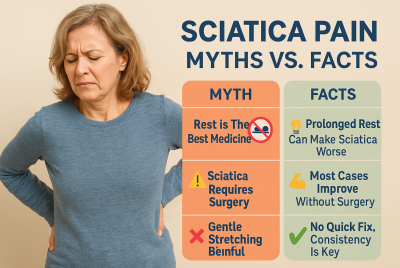DIY Sciatica Pain Relief Techniques
Natural & Effective Remedies
Discover effective DIY sciatica pain relief techniques to ease nerve pain naturally with stretches, massages, heat therapy, and more! Sciatica is a common condition that causes pain, tingling, and discomfort along the sciatic nerve, which runs from the lower back through the hips and down each leg. This pain can range from mild to severe, often interfering with daily activities. While medical treatment is available, many people prefer natural, at-home remedies to relieve sciatica pain. In this guide, we’ll explore the best DIY sciatica pain relief techniques that can help you manage and reduce discomfort effectively.
Understanding Sciatica
Sciatica occurs when the sciatic nerve becomes compressed or irritated due to conditions such as herniated discs, spinal stenosis, or piriformis syndrome. Common symptoms include:
- Sharp or burning pain radiating from the lower back down one or both legs
- Numbness or tingling in the affected leg
- Weakness in the affected limb
- Increased pain when sitting or standing for long periods
By addressing the root causes and incorporating natural relief methods, you can reduce symptoms and improve mobility.
DIY Sciatica Pain Relief Techniques
Stretching Exercises
Stretching helps loosen tight muscles, improve flexibility, and reduce sciatic nerve pressure. Try these simple yet effective stretches:
Piriformis Stretch
- Sit on the floor with one leg crossed over the other.
- Hold the knee of the crossed leg and gently pull it toward your opposite shoulder.
- Hold for 20-30 seconds and switch sides.
Seated Spinal Twist
- Sit on a chair with feet flat on the ground.
- Twist your upper body to one side while keeping your hips facing forward.
- Hold for 15-20 seconds and repeat on the other side.
Hamstring Stretch
- Lie on your back and raise one leg.
- Hold behind the thigh and gently pull toward your chest.
- Hold for 20 seconds and switch legs.
Cold and Heat Therapy
Alternating between cold and heat therapy can relieve inflammation and promote circulation.
- Cold Therapy: Apply an ice pack to the lower back for 15-20 minutes to reduce inflammation.
- Heat Therapy: Use a heating pad or warm compress for 15-20 minutes to relax muscles and improve blood flow.
Repeat this cycle 2-3 times daily for optimal relief.
Foam Rolling & Massage
Self-massage and foam rolling can help relieve muscle tension and break up tight fascia around the sciatic nerve.
- Use a foam roller under your lower back, glutes, and hamstrings, rolling gently for 1-2 minutes.
- Apply gentle pressure using a tennis ball or massage tool on sore areas for deep tissue relief.
Essential Oils for Sciatica Relief
Certain essential oils have anti-inflammatory and pain-relieving properties. Some of the best oils for sciatica relief include:
Peppermint Oil: Reduces muscle spasms and provides a cooling sensation.
Lavender Oil: Relieves muscle tension and promotes relaxation.
Eucalyptus Oil: Has anti-inflammatory properties that help ease nerve pain.
Mix a few drops with a carrier oil (like coconut or olive oil) and massage onto the affected area.
Posture Correction & Ergonomics
Poor posture can aggravate sciatica pain. To prevent and manage discomfort:
- Maintain a straight spine while sitting and use lumbar support cushions.
- Keep your feet flat on the floor while working at a desk.
- Avoid prolonged sitting by taking frequent breaks and stretching.
Yoga for Sciatica Relief
Yoga improves flexibility, strengthens core muscles, and alleviates nerve pain. The following yoga poses are particularly beneficial:
Child’s Pose: Stretches the lower back and relieves tension.
Cat-Cow Stretch: Improves spinal mobility and reduces stiffness.
Pigeon Pose: Stretches the hip muscles that may be pressing on the sciatic nerve.
Practice these poses daily for 10-15 minutes.
Hydration & Anti-Inflammatory Diet
Staying hydrated and eating anti-inflammatory foods can promote healing and reduce nerve pain. Include:
Foods Rich in Omega-3s: Salmon, flaxseeds, and walnuts.
Turmeric & Ginger: Natural anti-inflammatories that help reduce pain.
Leafy Greens & Berries: Packed with antioxidants that aid nerve function.
Plenty of Water: This keeps the body hydrated and supports overall health.
Epsom Salt Bath
Epsom salt baths are known to ease muscle soreness and inflammation. Simply add 2 cups of Epsom salt to warm bath water and soak for 20-30 minutes. The magnesium in Epsom salt helps relax muscles and reduce nerve pain.
Herbal Remedies & Supplements
Certain herbs and supplements may provide natural sciatica relief. Some effective options include:
Turmeric (Curcumin): Known for its anti-inflammatory properties.
Devil’s Claw: An herbal remedy that may help reduce nerve pain.
Magnesium Supplements: Helps relax muscles and prevent spasms.
Vitamin B12: Supports nerve health and function.
Lifestyle Modifications for Long-Term Relief
Making small changes in your daily routine can prevent recurring sciatica pain. Consider:
Regular Physical Activity: Engage in low-impact exercises like swimming or walking.
Weight Management: Maintaining a healthy weight reduces pressure on the sciatic nerve.
Proper Sleeping Position: Sleep on your side with a pillow between your knees for spinal alignment.
Avoid Heavy Lifting: When lifting, bend at the knees and keep your back straight.
When to Seek Medical Attention
While these DIY techniques can be effective, it’s important to consult a healthcare professional if:
- Pain persists or worsens despite self-care measures.
- You experience severe pain, numbness, or muscle weakness.
- Symptoms affect both legs or are accompanied by bladder or bowel control issues.
Early medical intervention can prevent complications and promote a quicker recovery.
FAQs Related to DIY Sciatica Pain Relief Techniques
Can sciatica go away on its own?
Yes, mild cases of sciatica often resolve on their own with rest, stretching, and self-care.
How long does it take for sciatica to heal?
Recovery time varies but typically takes a few weeks to several months, depending on the severity.
What is the best sleeping position for sciatica?
Sleeping on your side with a pillow between your knees helps align the spine and relieve pressure.
Can walking help with sciatica pain?
Yes, gentle walking can improve circulation and reduce nerve pressure, but avoid overexertion.
Are there any activities to avoid with sciatica?
Avoid heavy lifting, prolonged sitting, and high-impact exercises that may worsen symptoms.
Can a chiropractor help with sciatica?
Yes, chiropractic adjustments can help realign the spine and relieve nerve compression.
What are the best exercises to prevent sciatica?
Strengthening core muscles, simple stretching, and practicing good posture can help prevent recurrence.
DIY Sciatica Pain Relief Techniques – Final Thoughts
DIY sciatica pain relief techniques can be highly effective when practiced consistently. From stretching and massage to essential oils and lifestyle modifications, these natural remedies offer a holistic approach to managing sciatic nerve pain. If symptoms persist or worsen, it’s essential to consult a healthcare professional for a proper diagnosis and treatment plan.
By incorporating these self-care techniques into your routine, you can take control of your sciatica pain and enjoy a more active, pain-free life.
Disclaimer
Please note that this article should not replace professional medical advice. Consult a healthcare professional for an accurate diagnosis and tailored treatment plan.






